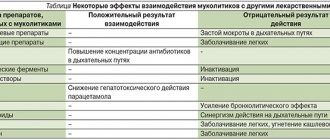What is Lazolvan
A medicine based on the active substance ambroxol hydrochloride. Designed to liquefy viscous mucous secretions and remove them from the lungs. The product is produced in several forms:
- inhalation solution: transparent light brown liquid containing 7.5 mg of ambroxol, in 100 ml bottles with dispensers and measuring cups;
- tablets for oral administration: round, yellowish, 30 mg each, in blisters with cells of 10 pcs.;
- children's syrup: viscous transparent liquid of a sweetish taste containing 15 mg of ambroxol, bottles of 100–200 ml;
- medicinal lozenges for resorption: brown, mint-scented, contain 15 mg of active ingredient.
Pharmacological properties of the drug Lazolvan solution for infusion
Pharmacodynamics. Ambroxol - the active ingredient of the drug Lazolvan increases the secretion of mucus in the respiratory tract. Ambroxol enhances the synthesis of pulmonary surfactant and stimulates ciliary activity. These effects lead to improved mucus separation and elimination (mucociliary clearance). Activation of fluid secretion and increased mucociliary clearance facilitate the removal of mucus and reduce cough. In vitro studies have demonstrated that the drug reduces the number of cytokines, as well as the number of tissue-associated mononuclear cells and polymorphonuclear cells. Pharmacokinetics. Ambroxol binds to plasma proteins by approximately 90% in adults and 60–70% in newborns. Ambroxol penetrates the placental barrier and reaches the lungs of the fetus. A large volume of distribution of 6–7 l/kg indicates accumulation of the substance in tissues; Compared to the content in the blood plasma, the concentration in the lung tissue exceeds the corresponding indicator in the blood plasma by a factor of 17. Studies with human liver microsomes have shown that CYP 3A4 is the dominant isoenzyme responsible for the metabolism of ambroxol. Consequently, ambroxol is mainly metabolized in the liver by phase II metabolism (to glucuronides) and is cleaved to dibromoantranilic acid (8–10% of the dose), with the exception of a few minor metabolites. All of these metabolites (80–90%) are excreted in the urine. 4.6% of the IV administered dose of the drug is determined as the active substance in the urine, while the conjugated metabolite in the urine accounts for 35.6% of the dose. The half-life of ambroxol from blood plasma is 10 hours. In newborns, after repeated intravenous administration, the half-life increases approximately 2 times due to reduced clearance.
How to use Lazolvan to treat children
For coughs and other respiratory tract lesions in children under 6 years of age, use the drug in syrup:
- children under 2 years of age: 2–2.5 ml twice a day;
- at 3–6 years: 3 ml, repeating the dose twice;
- from 6 to 12 years: 5 ml up to three times a day.
Adolescents over 12 years of age are allowed to consume 10 ml of syrup 2-3 times a day.
From the age of 6, you can give children lozenges: 1–2 pieces. three times a day. All forms of Lazolvan are compatible with food. Gastric juice does not affect the effect of the drug. During treatment, it is important to give your child plenty of fluids to drink. It is necessary for better separation of sputum.
Special instructions for the use of the drug Lazolvan solution for infusion
The sodium concentration in one recommended dose is less than 1 mmol (23 mg). Very rarely, severe skin lesions have been reported - Stevens-Johnson and Lyell syndromes, temporarily associated with the use of mucolytic agents such as ambroxol. Basically, their appearance could be explained by the severity of the underlying disease or the use of concomitant medications. If there is severe damage to the skin or mucous membranes, you should immediately reconsider therapy and stop using ambroxol.


